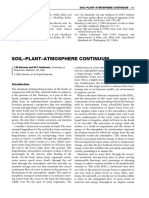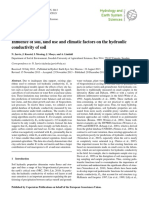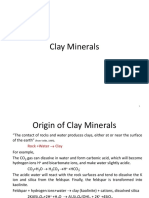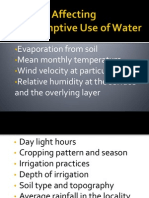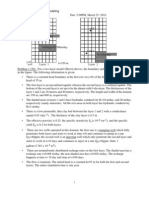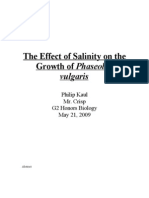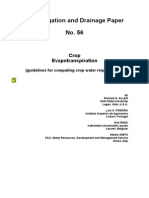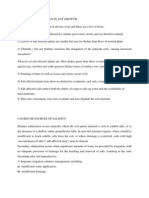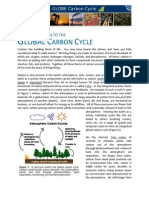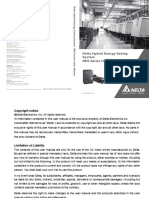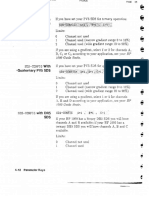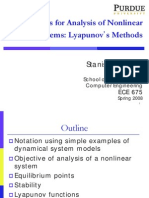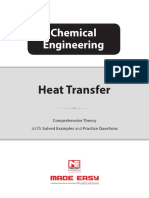Steady-State Water Flow in Porous Media: Hillel, 1982
Steady-State Water Flow in Porous Media: Hillel, 1982
Uploaded by
mikiprofaCopyright:
Available Formats
Steady-State Water Flow in Porous Media: Hillel, 1982
Steady-State Water Flow in Porous Media: Hillel, 1982
Uploaded by
mikiprofaOriginal Title
Copyright
Available Formats
Share this document
Did you find this document useful?
Is this content inappropriate?
Copyright:
Available Formats
Steady-State Water Flow in Porous Media: Hillel, 1982
Steady-State Water Flow in Porous Media: Hillel, 1982
Uploaded by
mikiprofaCopyright:
Available Formats
Steady-State Water Flow: Theory, D. L.
Nofziger
General Description Model Description Simplifications Glossary Bibliography and Contributors
Steady-State Water Flow in Porous Media The rate of water flow and the distribution of water potentials in a one-dimensional soil column under steady-state conditions can be obtained by solving the Darcy or Buckingham-Darcy equation. When soils are saturated and homogeneous, the calculation is easy. The problem becomes more difficult when the soil is not homogeneous or when it is unsaturated. This program uses numerical methods to evaluate the flow rate of water, the equivalent conductivity of the soil, and soil-water potentials in a one-dimensional flow system composed of one or two layers of soil. The flow rate, equivalent conductivity, and a graph of total potential, matric potential, gravitational potential, conductivity, driving force, or water content as a function of position along the soil column are then displayed. Model Description Darcys equation is often used to describe water movement in saturated soils. For onedimensional water flow, it can be written as ( Hillel, 1982)
where q is the flux density of water passing through the soil, K is the saturated hydraulic conductivity, H is the total potential, and x is the position coordinate. For unsaturated soils, this equation takes the modified form developed by Buckingham (1907)
where K() or K(h) is the unsaturated hydraulic conductivity function ( Brooks and Corey, 1964; Gardner, 1958; vanGenuchten, 1980), is the volumetric water content and h is the matric potential. The total potential is the sum of the matric potential and gravitational potential. For uniform saturated soils we can write this equation as
file:///C|/SoilPhysics/software/DarcyFlow/document.html (1 of 5)2/28/2005 4:10:49 PM
Steady-State Water Flow: Theory, D. L. Nofziger
where H1 and H2 are the total potentials at the inlet and outlet of the soil system, respectively. The difference in total potential divided by the length of the system is the driving force causing water to flow. This equation is applicable to layered or unsaturated soils if the hydraulic conductivity, K, in the equation is regarded as the equivalent conductivity of the entire soil system. When soils are saturated and homogeneous, the flux density can be easily obtained if the conductivity of the soil is known and the total potential or matric potential at the ends of the soil are specified. However, the problem becomes more difficult when the soil is not homogeneous or when it is unsaturated. This program considers one-dimensional flow in a soil. The soil is assumed to be either homogeneous or composed of two layers. In a homogeneous soil system, the conductivity will be uniform throughout if the matric potentials at both ends are zero or more since that means the soil is saturated. If one or more matric potentials are less than zero, the conductivity and water content can change with position. In a layered soil system, the conductivity will not be uniform throughout even if the soil is saturated. The program allows a user to select a soil system made up of one or two layers from the dropdown "Preferences" menu. If a two-layer system is selected, the user can specify the length or thickness of each layer in the soil system, the saturated hydraulic conductivity of each layer, the total potential or matric potential at each end of the soil, and the orientation of the soil. The user can also define for each layer the water content and hydraulic conductivity as functions of matric potential that are needed for unsaturated flow. When an one-layer system is selected, the user only needs to specify the thickness and hydraulic parameters for the single layer along with the potentials at the ends of the soil system and its orientation. The software then solves the equations above for the system and displays graphs of total potential, matric potential, gravitational potential, conductivity, driving force, or water content as a function of position along the soil column. In this way the user can see the impact of changes in matric potential and water content upon the flow rate and equivalent conductivity of the entire soil system. Assumptions and Simplifications Simplifications and assumptions on soil media and flow conditions: 1. This software assumes that flow is strictly one-dimensional.
file:///C|/SoilPhysics/software/DarcyFlow/document.html (2 of 5)2/28/2005 4:10:49 PM
Steady-State Water Flow: Theory, D. L. Nofziger
2. Flow-induced deformation in a soil medium affects the shape, size, and connectivity of soil pores, which largely determines the hydraulic properties of a soil system ( Buckingham, 1907). In this program, it is assumed that the soil system simulated in this program is rigid, i.e., no flow-induced deformation occurs. 3. Flow through conduits is classified into laminar flow and turbulent flow dependent on the ratio of inertial to viscous forces exerted on the fluids( Bear, 1972). In laminar flow, the relationship between flow rate and gradient in total potential is linear, while in a turbulent flow the relationship is nonlinear. The proportional relationship of Darcy's law is valid in the range of laminar flow only. Hence, an implicit assumption in this program is that flow conditions inside soil pores are laminar. 4. In fine-grained (especially clayey) soils, a minimum potential gradient called threshold gradient may exist. Below this threshold gradient there is very little flow. This non-Darcy behavior(Swartzendruber, 1962) may be due to the effect of stream potential which generates small countercurrents along the pore walls in a direction opposite that of the main flow (Bear, 1972). Another explanation for the non-Darcy behavior is the nonNewtonian liquid viscosity caused by clay-water interaction. In this program, non-Darcy behavior is ignored. Glossary Equivalent Conductivity: The equivalent conductivity of a non-homogeneous soil is equal to the flux through that soil divided by the driving force or gradient in total potential across that soil. It could be considered the equivalent or average conductivity for the non-uniform soil. Flux Density: The flux density of water passing through a soil is the volume of water passing through the soil per unit cross-sectional area (perpendicular to the flow) per unit time. It has units of length per unit time such as mm/sec, mm/hour, or inches/day. Many times flux and flux density are used interchangeably. Gravitational Potential: The gravitational potential of water is the amount of work required per unit quantity of water to move a very small amount of water reversibly and isothermally from a pool of pure water at atmospheric pressure at a reference level to another pool of pure water at the elevation of interest. This is simply the amount of work required to lift or lower the water from the reference level. (See also Units of Potential). Hydraulic Conductivity: The hydraulic conductivity of a soil is a measure of the ease at which water moves through the soil. It can be obtained experimentally by measuring the flux density of water passing through a soil, the difference in total potential and the length of the soil. The conductivity is the proportionality constant which when multiplied by the driving force (or
file:///C|/SoilPhysics/software/DarcyFlow/document.html (3 of 5)2/28/2005 4:10:49 PM
Steady-State Water Flow: Theory, D. L. Nofziger
gradient in total potential) causing water to move gives the flux density of water. If the potential is defined in terms of a unit weight of water, then the gradient in total head has no dimensions and the conductivity has units of length per unit time just as the flux density does. Matric Potential: The matric potential of water in a soil is the amount of work required per unit quantity of water to move a very small amount of water reversibly and isothermally from a pool of pure water at the elevation of interest and at atmospheric pressure to the point of interest in the soil. This is the amount of work required to move water into a soil from outside of it. Since the elevations are the same, gravity has no impact upon matric potential. Matric potential is another term for pressure potential or pressure head. (See also Units of Potential) Total Potential: The total potential of water in a soil is the amount of work required per unit quantity of water to move a very small amount of water reversibly and isothermally from a pool of pure water at atmospheric pressure and at a reference level to the point of interest in the soil. This is the sum of the matric potential and the gravitational potential. (See also Units of Potential) Units of Potential: All definitions of potential refer to work per unit quantity of water. The final units of potential depend upon the unit quantity of water chosen. It is convenient to define potential per unit weight of water. This means that all types of potential have units of length. This form of potential is often called "head". So we commonly talk of total head, gravitational head, and pressure head or matric head. Volumetric Water Content: The volume of water in a soil divided by the total volume of the soil (i.e. the sum of the volumes of solids and pores). Bibliography Bear, J., 1972. Dynamics of fluids in porous media. Dover Publications, Inc., 31 East 2nd Street, Mineola, NY 11501, pp. 119-194. Brooks, R. H., and A. T. Corey, 1964. Hydraulic properties of porous media. Colorado State University, Fort Collins, Colorado, Hydrology Paper no. 3. Buckingham, E., 1907. Studies on the movement of soil moisture. U.S. Dept. of Agr. Bur. Soils Bull. 38. Gardner, W. R., 1958. Some steady state solutions of the unsaturated moisture flow equation with application to evaporation from a water table. Soil Sci. 85:228-232.
file:///C|/SoilPhysics/software/DarcyFlow/document.html (4 of 5)2/28/2005 4:10:49 PM
Steady-State Water Flow: Theory, D. L. Nofziger
Hillel D. 1982. Introduction to soil physics. Academic Press, Inc. 1250 Sixth Avenue, San Diego, CA 92101. Swartzendruber D. 1962. Non-Darcy flow behavior in liquid-saturated porous media. J. Geophys. Res. 67:5205-5213. van Genuchten, M. Th., 1980. A closed-form equation for predicting the hydraulic conductivity of unsaturated soils. Soil Sci. Soc. Am. J. 44:892-898. Contributors This program was designed by Dr. D. L. Nofziger and Dr. J. Wu, Department of Plant and Soil Sciences, Oklahoma State University, Stillwater, OK 74078. Send email to dln@okstate.edu Last Modified: March 18, 2003.
file:///C|/SoilPhysics/software/DarcyFlow/document.html (5 of 5)2/28/2005 4:10:49 PM
You might also like
- Theoretical Correlation Spray-Dryer Performance: R. GillilandDocument7 pagesTheoretical Correlation Spray-Dryer Performance: R. GillilandMario LlanoNo ratings yet
- EES217-06-Groundwater - Lecture 2 PDFDocument53 pagesEES217-06-Groundwater - Lecture 2 PDFRizkyy Rachmalya ZainalNo ratings yet
- Soil WashingDocument19 pagesSoil WashingLTE002No ratings yet
- Global Environment: Water, Air, and Geochemical Cycles - Second EditionFrom EverandGlobal Environment: Water, Air, and Geochemical Cycles - Second EditionRating: 5 out of 5 stars5/5 (1)
- Arnold-Inverse Pressure Gradient MatchingDocument7 pagesArnold-Inverse Pressure Gradient MatchingredxusNo ratings yet
- Soil Physics ExerciseDocument14 pagesSoil Physics ExerciseChanako DaneNo ratings yet
- Water Flow in Saturated Soils Darcy's Law: CE/ENVE 320 - Vadose Zone Hydrology/Soil Physics Spring 2004Document41 pagesWater Flow in Saturated Soils Darcy's Law: CE/ENVE 320 - Vadose Zone Hydrology/Soil Physics Spring 2004joo12345678910No ratings yet
- 2.soil Physics IDocument32 pages2.soil Physics ISilvio GumiereNo ratings yet
- Chapter-1-Intro SoilDocument103 pagesChapter-1-Intro Soilkylle autorNo ratings yet
- 483 - Sos 211 Lecture NoteDocument64 pages483 - Sos 211 Lecture NoteFarai Faustos100% (1)
- Soil Physical Properties - 03!02!2023Document68 pagesSoil Physical Properties - 03!02!2023Gabby ChebetNo ratings yet
- Classification of Soil ColloidsDocument92 pagesClassification of Soil ColloidsAlipsa Samal B (221210096)No ratings yet
- m3l02 M3 L2 Soil Water Plant RelationshipsDocument18 pagesm3l02 M3 L2 Soil Water Plant RelationshipspaajiNo ratings yet
- Interstratified Clay MineralsDocument3 pagesInterstratified Clay MineralsPavithra Selvaraj100% (1)
- Contributed Papers: Cordoba Spain 13-17 March 2000Document448 pagesContributed Papers: Cordoba Spain 13-17 March 2000remikhaledNo ratings yet
- Hydrology and Climatology For BSC Forestry StudentsDocument83 pagesHydrology and Climatology For BSC Forestry StudentsMadan ThapaNo ratings yet
- 1st Mid PartDocument13 pages1st Mid PartAbdullah Al Mamun100% (1)
- Soil Plant Atmoshere Continuum PDFDocument9 pagesSoil Plant Atmoshere Continuum PDFAnuragNo ratings yet
- Book Exercises in Soil PhysicsDocument340 pagesBook Exercises in Soil PhysicsVíctor PradoNo ratings yet
- Soil Physics Exp: 1. To Study The Relationship Between The Physical Properties of Soil and DepthDocument3 pagesSoil Physics Exp: 1. To Study The Relationship Between The Physical Properties of Soil and DepthAamir khanNo ratings yet
- Stwes Class GlasodDocument5 pagesStwes Class GlasodNadya Anggi HastitiNo ratings yet
- Chapter 2 Soil-Water-PlantDocument50 pagesChapter 2 Soil-Water-PlantMūssā Mūhābā ZēĒthiopiāNo ratings yet
- Soil Texture AnalysisDocument10 pagesSoil Texture AnalysisMarkPNo ratings yet
- Influence of Soil, Land Use and Climatic Factors On The Hydraulic Conductivity of SoilDocument11 pagesInfluence of Soil, Land Use and Climatic Factors On The Hydraulic Conductivity of Soilabi zarkasyiNo ratings yet
- Tackling of Alkaline Soil and Brackish Water in Pakistan and Improvement of Urea and CAN Fertilizers Efficiency PDF 2Document11 pagesTackling of Alkaline Soil and Brackish Water in Pakistan and Improvement of Urea and CAN Fertilizers Efficiency PDF 2RanaNaqushbandKhanNo ratings yet
- UNIT 9 - Soil ConservationDocument53 pagesUNIT 9 - Soil ConservationMaria Lourdes samontinaNo ratings yet
- Estadística. Serie Schaum - 4ta Edición - Murray R. Spiegel PDFDocument66 pagesEstadística. Serie Schaum - 4ta Edición - Murray R. Spiegel PDFCristian Villa SiordiaNo ratings yet
- Clay MineralDocument22 pagesClay MineralvenudreamerNo ratings yet
- Grade 10 Hydrology 2023Document27 pagesGrade 10 Hydrology 2023Andre Birch100% (1)
- Soil Water BalanceDocument9 pagesSoil Water BalanceabiNo ratings yet
- Factors Affecting Consumptive Use of WaterDocument17 pagesFactors Affecting Consumptive Use of WaterMonde Nuylan100% (2)
- Groundwater Modelling ReportDocument115 pagesGroundwater Modelling ReportparagjduttaNo ratings yet
- 2A Huang 03 26 10 PaperDocument9 pages2A Huang 03 26 10 PaperReem AlaaNo ratings yet
- HPPT 1Document127 pagesHPPT 1manaseessau5No ratings yet
- Absorption Water Content and Liquid LimitDocument7 pagesAbsorption Water Content and Liquid LimitChandan BleeNo ratings yet
- Irrigation Water Quality CriteriaDocument4 pagesIrrigation Water Quality CriteriadejayzNo ratings yet
- Homework 2Document3 pagesHomework 2bigs1303No ratings yet
- Chapter 3-Surface Irrigation DesignDocument68 pagesChapter 3-Surface Irrigation DesignEng Ahmed abdilahi IsmailNo ratings yet
- Soil As A ResourceDocument32 pagesSoil As A Resourcehoabeo1984No ratings yet
- MN Analysis MethodDocument18 pagesMN Analysis MethodsunnyleleNo ratings yet
- Drainage EquationDocument3 pagesDrainage EquationMonika KshNo ratings yet
- Topics For Environmental ScienceDocument5 pagesTopics For Environmental ScienceRoeliza De leonNo ratings yet
- Soil Quality and Soil Healthpdf PDFDocument20 pagesSoil Quality and Soil Healthpdf PDFrifqi wisnuNo ratings yet
- EES217 06 Groundwater Lecture 2Document53 pagesEES217 06 Groundwater Lecture 2Muhshonati SyahidahNo ratings yet
- The Effect of Salinity On The Growth of Phaseolus VulgarisDocument11 pagesThe Effect of Salinity On The Growth of Phaseolus VulgarisPhilip KaulNo ratings yet
- SL 101 - Soil Chemical PropertiesDocument44 pagesSL 101 - Soil Chemical PropertiesNeville TNo ratings yet
- Fao Irrigation and Drainage Paper 56Document326 pagesFao Irrigation and Drainage Paper 56M Nur SalimNo ratings yet
- Filter Paper Method of Soil Suction MeasurementDocument5 pagesFilter Paper Method of Soil Suction MeasurementsaiNo ratings yet
- Effects of Salinity On Plant GrowthDocument4 pagesEffects of Salinity On Plant GrowthFelix King MensahNo ratings yet
- Soil ColloidsDocument8 pagesSoil ColloidsSavannah Simone PetrachenkoNo ratings yet
- Scenario Analysis of Rice Cultivation in Kerala: H. Athira and N. Kishore KumarDocument4 pagesScenario Analysis of Rice Cultivation in Kerala: H. Athira and N. Kishore KumarNimisha vk100% (1)
- Bouwer Rice Slug Test Hydraulic Conductivity WRR1976Document6 pagesBouwer Rice Slug Test Hydraulic Conductivity WRR1976Simson MuliaNo ratings yet
- Potential of Vetiver For Groundwater RechargeDocument27 pagesPotential of Vetiver For Groundwater Rechargeapi-19745097No ratings yet
- Importance of Soil and 14 Best UsesDocument2 pagesImportance of Soil and 14 Best Usesadipoliachayan5235No ratings yet
- CarbonCycleBackground PDFDocument12 pagesCarbonCycleBackground PDFMusdq ChowdhuryNo ratings yet
- 3.1 Introduction To BiodiversityDocument11 pages3.1 Introduction To BiodiversityYohanes Sumantri RatnodiyantoNo ratings yet
- Soil Colloid 2Document24 pagesSoil Colloid 2Muhammad Yusuf100% (1)
- Our Soil Testing Methods - Soil Testing Laboratory - University of MinnesotaDocument5 pagesOur Soil Testing Methods - Soil Testing Laboratory - University of MinnesotaNabil Abo TalebNo ratings yet
- Dakolias BrochureDocument6 pagesDakolias BrochureCharles IppolitoNo ratings yet
- Environmental Isotopes in The Hydrological Cycle Vol 1 PDFDocument185 pagesEnvironmental Isotopes in The Hydrological Cycle Vol 1 PDFNoreida PRIETO MILLAN100% (1)
- 1 Delta Ia-Mds Vfd-Hes UmDocument230 pages1 Delta Ia-Mds Vfd-Hes UmPREVENCIONISTA HUAQUIANNo ratings yet
- ImplosionDocument134 pagesImplosionAmanat Hossain SumonNo ratings yet
- Libd ChartsDocument29 pagesLibd ChartsCasNo ratings yet
- J R Rice - Path Independentt Integral - JAM68Document8 pagesJ R Rice - Path Independentt Integral - JAM68CJCONSTANTENo ratings yet
- Facts at Your Fingertips-201005-Burner Operating Characteristics PDFDocument1 pageFacts at Your Fingertips-201005-Burner Operating Characteristics PDFonizuka-t2263No ratings yet
- Roots of Quadratic FunctionDocument15 pagesRoots of Quadratic FunctionAsi SiaNo ratings yet
- Universes Within 106Document14 pagesUniverses Within 106Simed Ewei100% (4)
- HAISUNG Good3 - LowBacklash Reducer - CatalogDocument12 pagesHAISUNG Good3 - LowBacklash Reducer - Catalog032indesignNo ratings yet
- Agilent HP 1090 OvenDocument8 pagesAgilent HP 1090 OvenHamidNo ratings yet
- PHYSICS 151 - Notes For Online Lecture #19: Conservation of Linear Momentum in 2-DDocument4 pagesPHYSICS 151 - Notes For Online Lecture #19: Conservation of Linear Momentum in 2-DCece SantosNo ratings yet
- The Energy Machine of Joseph Newman - SearchableDocument338 pagesThe Energy Machine of Joseph Newman - Searchablesteve333880% (5)
- A Fundamental Conundrum in Psychology's Standard Model of Measurement and Its Consequences For Pisa Global Rankings.Document10 pagesA Fundamental Conundrum in Psychology's Standard Model of Measurement and Its Consequences For Pisa Global Rankings.Unity_MoT100% (1)
- 05 PresbyopiaDocument48 pages05 PresbyopiaAzmaNo ratings yet
- Lyapunov TutorialDocument104 pagesLyapunov Tutorialrin9100% (2)
- Cell Energy 2013 NotesDocument90 pagesCell Energy 2013 Notesapi-26963416No ratings yet
- Kinetic Theory of GasesDocument6 pagesKinetic Theory of GasesSasidaran SasiNo ratings yet
- AES Track Petroleum Engineering & Geosciences (PE&G) enDocument41 pagesAES Track Petroleum Engineering & Geosciences (PE&G) enrahulprabhakaranNo ratings yet
- A Novel Supply-Independent Biasing Scheme For Use in CMOS Voltage ReferenceDocument4 pagesA Novel Supply-Independent Biasing Scheme For Use in CMOS Voltage ReferenceshastryNo ratings yet
- MSDS 134aDocument7 pagesMSDS 134aGamaliel Efren Santibañez RomeroNo ratings yet
- Abstract - New Slip-Line Field Solutions Are Proposed For End Extrusion Through Square Dies WithDocument9 pagesAbstract - New Slip-Line Field Solutions Are Proposed For End Extrusion Through Square Dies WithGeoffrey ArmstrongNo ratings yet
- Principles of PC, TLC and HPLC andDocument5 pagesPrinciples of PC, TLC and HPLC andjust-maybe202No ratings yet
- STG Standstill Preservation MeasuresDocument4 pagesSTG Standstill Preservation MeasuresBala VivekanandanNo ratings yet
- Maintenance Component Main Function Level Activity Frequency Line DepartmentDocument7 pagesMaintenance Component Main Function Level Activity Frequency Line DepartmentBarath100% (1)
- CMOS Fabrication ProcessDocument45 pagesCMOS Fabrication ProcessManasa UpadhyayaNo ratings yet
- Centrifugal CompressorDocument2 pagesCentrifugal CompressorAyman EsaNo ratings yet
- Geography I.A.Document17 pagesGeography I.A.Jared Stewart0% (1)
- Ex 4 Effect of PH On Enzyme ActivityDocument2 pagesEx 4 Effect of PH On Enzyme ActivityRochel CaduyacNo ratings yet
- Heat Transfer THDocument14 pagesHeat Transfer THKalil BashaNo ratings yet


















